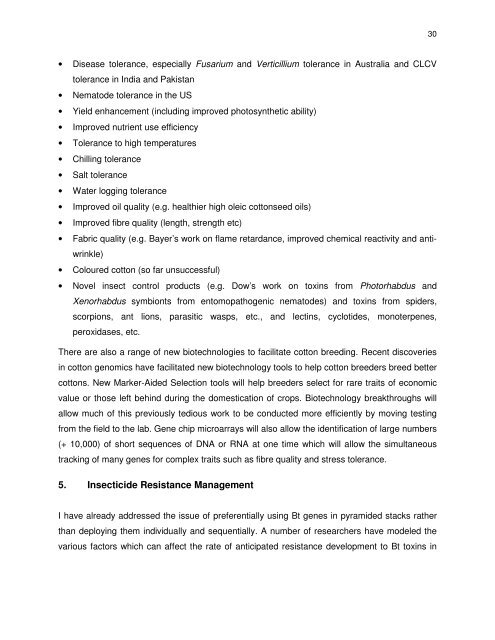ChangingCottonLandscapeNeilForrester
ChangingCottonLandscapeNeilForrester
ChangingCottonLandscapeNeilForrester
You also want an ePaper? Increase the reach of your titles
YUMPU automatically turns print PDFs into web optimized ePapers that Google loves.
• Disease tolerance, especially Fusarium and Verticillium tolerance in Australia and CLCV<br />
tolerance in India and Pakistan<br />
• Nematode tolerance in the US<br />
• Yield enhancement (including improved photosynthetic ability)<br />
• Improved nutrient use efficiency<br />
• Tolerance to high temperatures<br />
• Chilling tolerance<br />
• Salt tolerance<br />
• Water logging tolerance<br />
• Improved oil quality (e.g. healthier high oleic cottonseed oils)<br />
• Improved fibre quality (length, strength etc)<br />
• Fabric quality (e.g. Bayer’s work on flame retardance, improved chemical reactivity and anti-<br />
wrinkle)<br />
• Coloured cotton (so far unsuccessful)<br />
• Novel insect control products (e.g. Dow’s work on toxins from Photorhabdus and<br />
Xenorhabdus symbionts from entomopathogenic nematodes) and toxins from spiders,<br />
scorpions, ant lions, parasitic wasps, etc., and lectins, cyclotides, monoterpenes,<br />
peroxidases, etc.<br />
There are also a range of new biotechnologies to facilitate cotton breeding. Recent discoveries<br />
in cotton genomics have facilitated new biotechnology tools to help cotton breeders breed better<br />
cottons. New Marker-Aided Selection tools will help breeders select for rare traits of economic<br />
value or those left behind during the domestication of crops. Biotechnology breakthroughs will<br />
allow much of this previously tedious work to be conducted more efficiently by moving testing<br />
from the field to the lab. Gene chip microarrays will also allow the identification of large numbers<br />
(+ 10,000) of short sequences of DNA or RNA at one time which will allow the simultaneous<br />
tracking of many genes for complex traits such as fibre quality and stress tolerance.<br />
5. Insecticide Resistance Management<br />
I have already addressed the issue of preferentially using Bt genes in pyramided stacks rather<br />
than deploying them individually and sequentially. A number of researchers have modeled the<br />
various factors which can affect the rate of anticipated resistance development to Bt toxins in<br />
30


